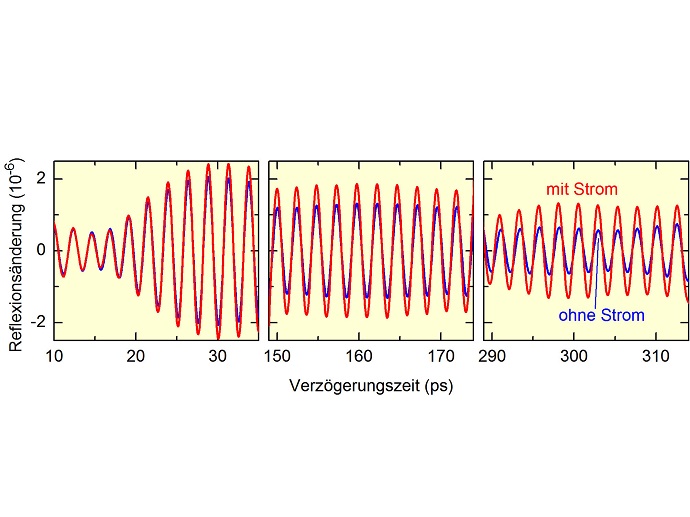22.02.2016
An electric current through a semiconductor nanostructure amplifies sound waves at ultrahigh frequency. This method allows for novel, highly compact sources of ultrasound, which can serve as diagnostic tool for imaging materials and biological structures with very high spatial resolution.
Ultrasound is an acoustic wave at a frequency well above the human audible limit. Ultrasound in the megahertz range (1 MHz = 106 Hz = 1 million oscillations per second) finds broad application in sonography for, e.g., medical imaging of organs in a body and nondestructive testing of materials. The spatial resolution of the image is set by the ultrasound wavelength. To image objects on the nanoscale (1 nanometer = 10-9 m = 1 billionth of a meter), sound waves with a frequency of several hundreds of gigahertz (1 gigahertz (GHz) = 1000 MHz) are required. To develop such waves into a diagnostic tool, novel sources and sound amplification schemes need to provide sufficient sound intensities.
In a recent publication (K. Shinokita et al., Phys. Rev. Lett. 116, 075504 (2016)), researchers from the Max-Born-Institut in Berlin together with colleagues from the Paul-Drude-Institut, Berlin, and the École Normale Supérieure, Paris, have demonstrated a new method for sound amplification in a specially designed semiconductor structure consisting of a sequence of nanolayers. Sound waves with a frequency of 400 GHz are generated and detected with short optical pulses from a laser. The sound is amplified by interaction with an electric current traveling through the semiconductor in the same direction as the sound waves. The sound amplification is based on a process called "SASER", the Sound Amplification by Stimulated Emission of Radiation, in full analogy to the amplification of light in a laser. The sound wave stimulates electrons moving with a velocity higher than the sound velocity, to go from a state of high energy to a state of lower energy and, thus, make the sound wave stronger. To achieve a net amplification, it is necessary that there are more electrons in the high-energy than in the lower-energy state. In this way, a 400 GHz sound wave is amplified by a factor of two.
The present work is a proof of principle. For a usable source of high-frequency sound waves, it is necessary to further increase the amplification, which should be possible by improving the design of the structure and, most importantly, better cooling of the semiconductor device. Once such a source is available, it can be used for extending the spatial resolution of sonography towards the scale viruses, a length scale much shorter than the wavelength of visible light.
Original Publication: Physical Review Letters 116, 075504
Strong Amplification of Coherent Acoustic Phonons by Intraminiband Currents in a Semiconductor Superlattice
Keisuke Shinokita, Klaus Reimann, Michael Woerner, Thomas Elsaesser, Rudolf Hey, Christos Flytzanis
This article was chosen as an Editor's suggestion, see also: Pumping up the sound















